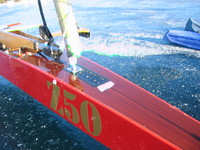Self Rescue - If you don't know, DON'T GO!
http://www.idniyra.org/articles/selfrescue.htm
Self-Rescue Technique
Self-Rescue Technique
by Bob Dill
Occasionally people find themselves in the water with wet, slippery black ice all around them. We had a near fatality in Vermont a few years ago when a skater tried to cross a pressure ridge. He stepped on a small loose plate and fell in. He had no ice picks and was unable to get out. His cries for help were heard by nearby iceboaters after he had been in the water for about 10 minutes. He was fairly hypothermic by the time we got him to shore.
To assess what is required to get out in this situation, we cut a hole in the ice and jumped in with rope and a dry suit on. By far the easiest way to get out is with ice picks, ice awls, bear claws or whatever you call them. If you don't have them, don't panic and act fast. Swim to the edge of the good ice, put your forearms on the ice, get your body near horizontal and with powerful frog kicks you can push yourself out. You should lift with your arms, but only straight up. This will help you get over the ice edge as you kick. Don't try to pull yourself out with your arms, they will only slip off. The idea is to keep yourself low and use the frog kick to push yourself onto the ice. Once out, get to shore or help quickly and out of your wet clothing as soon as possible.
A warm shower is almost always in order after a 32 degree swim. If a victim is having difficulty walking, talking or has a noticeable pallor or weak pulse in his extremities, call a rescue squad. Try to rewarm the victim in a shower or bath or at least with other people and warm drinks until the rescue squad arrives. Concentrate on warming the torso, not the extremities. The rescue squad should be called as soon as things even begin to look like significant hypothermia might be involved so they can be ready and waiting when the victim gets to shore.
I often wear a thin farmer John wet suit when sailing on questionable or unknown ice. They are comfortable, give good back padding for bumpy ice sailing and make being in the water much less dangerous and uncomfortable. The wet suit will also make getting to shore much less urgent. If you get wet a long distance off shore, this could be a crucial consideration.
___________________________________________________
I have heard stories (unconfirmed) that G107 used his running spikes as picks to remove himself from an umpleasant circumstance.
___________________________________________________
The speed suits most of us wear are really tri-lam dive suits and are about the same as 1/4" thick neoprene wet suit only comfortable. These suits upgrade a cold water imersion event from an immediate life threatening situation to about the most miserable experience of your life.
___________________________________________________
4695
- 2305 reads
